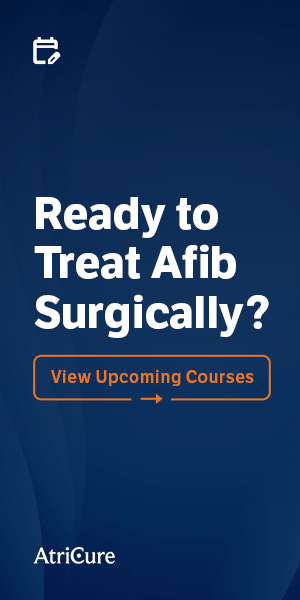The Sickest Afib Patients Get the Least Effective Treatment

How Hybrid AF Therapy breaks the cycle when medications fail and catheter ablation isn't enough
For patients who have long-standing persistent atrial fibrillation (LSPAF)—but who are not expected to have cardiac surgery in the near term—look to Hybrid AF™ Therapy. Hybrid AF Therapy, a Class II recommendation,1 is a combination of catheter ablation and minimally invasive epicardial surgical ablation.
Patients are commonly managed by primary care physicians or cardiologists who may not routinely refer them to electrophysiology (EP)—especially when symptoms are less severe or controlled by medication. Those medications, though, can’t halt Afib progression.
Know Your Afib Patients’ Trajectory
LSPAF patients have often experienced failed endocardial catheter ablation(s).
At this advanced stage of Afib, they also have:
- An enlarged left atrium
- A scarred left atrial posterior wall
- Comorbidities, such as heart failure
Those patients need an effective, society-recommended therapy to improve their symptoms and quality of life.
Sinus Rhythm: the Standard of Care for Advanced Afib Patients
Hybrid AF Therapy is the best option to get Advanced LSPAF patients—without structural heart disease—back into sinus rhythm. However, very few such patients are referred to an electrophysiologist for intervention.
Fewer than 3x of Afib patients are referred to EP.2-3
“We need to add not just years to life, but life to those years.”
– C. Michael Gibson M.A. (Hon.), M.D., FRCP, FAHA, FSCAI, FACC
Breaking the Afib Spiral: Referring to Electrophysiology Sooner
Patients with Advanced Afib should be referred earlier than they commonly are to EP. Endocardial catheter ablation alone is not indicated for these patients. However, Hybrid AF Therapy is an “advise to do” Class II recommendation from the Heart Rhythm Society1— making it a logical step to have patients assessed by EP.
Benefit of Hybrid AF Therapy Ablation
Catheter ablation is often effective at freeing paroxysmal patients from Afib. But once Afib progresses, medications are not curative. Hybrid AF Therapy ablation is the only proven minimally invasive procedure to treat this patient population. Note the data about Hybrid AF Therapy ablation—the procedure confers the following benefits:
Up to
88%
freedom of atrial arrhythmias
Up to
94%
Reduction in Afib burden to ≤5% 19-21
More than
3x
improvement in Afib symptoms 22
More than
2x
improvement in QOL scores 21
2x
More likely to no longer need medications for Afib 23
Early intervention is critical to halt Afib and heart failure. And recent consensus guidelines from the following societies state that treatment with an ablation strategy can reduce Afib burden.1
Hybrid AF Therapy Ablation—A Two-Stage Procedure
This minimally invasive surgery (MIS), which mimics the Cox-Maze procedure, combines epicardial and endocardial ablation in a two-stage process:
- Stage 1: MIS epicardial ablation + left atrial appendage exclusion
- Stage 2: Endocardial mapping and ablation
Medical management—to treat rate and rhythm—is often used to treat Afib. But once Afib progresses, despite medical management, the best chance to free the patient from Afib is with Hybrid AF Therapy ablation.

